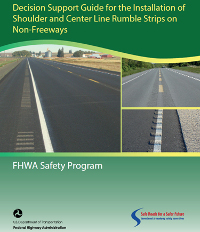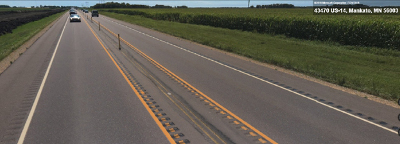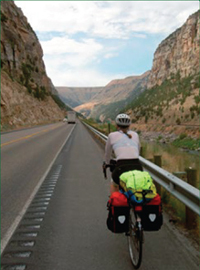Shoulder and Center Line Rumble Strips on Non-Freeways
by Airton Kohls (Source: FHWA Safety Programs)
Center line and shoulder rumble strips are proven safety countermeasures for reducing roadway departure crashes, including head-on crashes and run-off-road (ROR) crashes. According to a recent study from the National Highway Traffic Safety Administration, or NHTSA (DOT HS 811 500), ROR left or right crashes account for 64.4 percent of all single vehicle crashes and, of those, 95.1 percent of the time the critical reasons were driver related. Further analysis indicated the dominant critical reasons for passenger cars were internal driver distraction, steering overcompensation, poor directional control, too fast for curve, and sleeping. The dominant critical reason for large trucks was sleeping. According to the Fatality Analysis Reporting System (FARS) data, approximately 55 percent of fatal crashes are those targeted by rumble strips. Moreover, for rural two-lane highways, that number increases to approximately 66 percent. Another 2009 NHTSA study reported that approximately 66 percent of ROR events were departures to the right and 31 percent were to the left.

Rumble strips are a relatively low-cost countermeasure and economic analyses have indicated benefit-cost (B/C) ratios that exceed 100 to 1 (i.e., 100 dollars saved for every 1 dollar spent). For this reason, shoulder rumble strips have been installed nearly system wide for the Interstate system and most freeways and expressways. However, agencies have had varying degrees of success installing center line and shoulder rumble strips on multilane and two-lane roadways. The three primary concerns for rumble strips for these highway types include the following:
- Inconvenience for bicyclists. Standard rumble strip dimensions used by most agencies are difficult to traverse if bicycle gaps are not provided, as they make the rider uncomfortable and may lead to loss of control.
- External noise pollution. Rumble strips alert motorists through noise and vibration. The noise generated by rumble strips is different than background traffic noise and is intermittent. This can create a disturbance for nearby residents and for special environmental conditions (e.g., noise-sensitive wildlife habitats) if there are frequent incidental contacts.
- Pavement durability. There is concern that milling rumble strips into longitudinal joints or into the wearing course will allow water infiltration causing premature pavement deterioration.
FHWA Safety program has released a Decision Support Guide for the Installation of Shoulder and Center Line Rumble Strips on Non-Freeways (http://safety.fhwa.dot.gov/roadway_dept/pavement/rumble_strips/fhwasa16115/fhwasa16115.pdf). The purpose of this guide is to inform agencies on center line and shoulder rumble strip installation. It describes methods for identifying appropriate locations for installation, assessing the potential crash reductions and benefit to cost ratio, and developing performance metrics for safety. Additionally, this guide discusses special considerations for rumble strip installations, identifies variability in current practices, and provides a decision-support framework for installing rumble strips.

The following are a few sources of information that you may find helpful to address the aforementioned primary concerns for the use of rumble strip on non-freeway highways:
Bicycle Accommodation:
Rumble Strip Implementation Guide:
Addressing Bicycle Issues on Two-Lane Roads http://safety.fhwa.dot.gov/roadway_dept/pavement/rumble_strips/bike_ig/rmbl_bikes_imp.pdf
Noise Issues:
Rumble Strip Implementation Guide:
Addressing Noise Issues on Two-Lane Roads http://safety.fhwa.dot.gov/roadway_dept/pavement/rumble_strips/media/RumbleStripGuide_Noise/noise_bpg.pdf
Pavement Issues:
Rumble Strip Implementation Guide:
Addressing Pavement Issues on Two-Lane Roads http://safety.fhwa.dot.gov/roadway_dept/pavement/rumble_strips/media/RumbleStripGuide_Pavement/pavement_bpg.pdf
This FHWA Guide also provides several case studies. For example, the picture on page 4 depicts a stretch of Highway 14, a major arterial in southern Minnesota, spanning from South Dakota to Wisconsin. A buffer consisting of a double striped yellow line with rumbles on each side of delineators was used as an interim typical section during a five year project to expand the highway to a four-lane expressway. The location had a significant above-average rate of fatal head-on crashes and the design proved to be effective, reducing fatal head-on and severe head-on injury crashes to zero.
